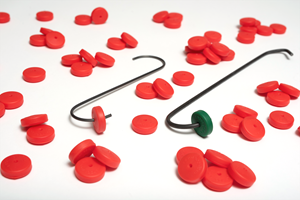CCAI
This month’s clinic will be devoted to a portion of the Electrocoat seminar presented in Livonia, MI in October by the Electrocoat Association and Chemical Coaters Association International (CCAI). I presented a short segment on some of the myths associated with e-coat.
This month’s clinic will be devoted to a portion of the Electrocoat seminar presented in Livonia, MI in October by the Electrocoat Association and Chemical Coaters Association International (CCAI). I presented a short segment on some of the myths associated with e-coat. An abbreviated version of that presentation follows.
Myth—Electrocoat is only available in black.
Fact: Electrocoat is available in all colors.
Comments: Because e-coat normally requires a substantial volume of parts (sq ft/hour or shift), each color requires a large volume to justify the cost of equipment. Multicolor systems have been designed and are in operation. Square transfer design requires less space (and lower cost) and less paint volume than monorail systems.
Colors are available in either epoxy or acrylic resin and either anodic or cathodic operating systems. The decision should be made on end-use coating performance and volume of each color.
Myth—Electrocoat is only used as a primer.
Fact: Electrocoat is available as a primer, one-coat finish or two-coat system.
Comments: E-coat was originally developed in the automotive industry as a primer to reduce red rust on cars. Most epoxy systems are usually used as primers or for high corrosion-resistant or indoor applications.
Most one-coat colors are for high-volume indoor or outdoor applications with minimal corrosion-resistant requirements. Very large one-coat systems have been developed to process complete agricultural equipment. Very small, multicolor, square transfer systems have also been built for one-coat coatings.
Two-coat systems are very popular with e-coat as the primer and powder or liquid topcoats for multicolor applications. Additional corrosion protection is provided by the e-coat (usually epoxy) with better transfer efficiency of the topcoat as only the exposed surfaces need coating and less film thickness is needed.
Two-coat e-coat systems are quite unique but offer all of the e-coat advantages on both coats. A special primer becomes conductive after curing so the topcoat can be applied.
Myth—Parts must be capable of racking in order to be electrocoated.
Fact: Parts not conducive for racking are capable of accepting an electrocoat finish in bulk systems.
Comments: Many unique racking systems have been designed to provide universal part presentation and grounding. Some have been designed to hold parts that do not have holes or drainage or air-pocket problems. Very small parts such as fasteners have been reasonably coated in bulk using baskets. Fairly new technology has been developed to coat small parts in tumblers.
Myth—Electrocoat systems are too expensive.
Fact: Electrocoat systems typically have the lowest applied cost per square foot. Comments: While initial capital equipment is expensive, the payback in labor and material savings is quite rapid, if volume of parts is high. “Applied cost” is the key as electrocoat has such a uniform coating thickness compared to liquid or powder, which easily can develop heavier than needed film thickness. With a true transfer efficiency of 95%+, e-coat does the best job of putting the coating on the part rather than the hooks, hangers, booths or up the stack.
With zero labor cost for coating application, e-coat does not rely on expensive coaters for application. The technician that monitors the washer can usually also monitor the e-coat system. Energy and environmental costs are usually much less than powder or liquid.
Myth—Electrocoat is a high-tech process that is difficult to run and maintain. Fact: Electrocoat systems are easily maintained by performing daily tests and making the appropriate adjustments.
Comments: While the amount of equipment looks (and is) substantial, and complex, the amount of automation should minimize operating problems. Relatively simple tests by a high school grad technician should be adequate to monitor the automation. Be sure to watch for a repeat of the Electrocoat seminar in Nashville and Milwaukee during 2005.
Related Content
Chicago-Based Anodizer Doubles Capacity, Enhancing Technology
Chicago Anodizing Company recently completed a major renovation, increasing its capacity for hardcoat anodizing and Type II anodizing.
Read MoreMaximize Your Racking Efficiency and Quality
Best practices for racking parts in surface finishing operations.
Read MoreTroubleshooting 5 Common Racking Problems for Platers
Being aware of usual issues that might occur during the plating process will prepare platers by helping them know how to avoid them all together or how to fix them if they happen.
Read MoreCFS Unveils New Hook Locks Parts Racking Solution
New product from Custom Fabricating & Supplies (CFS) prevents part loss during coating processes.
Read MoreRead Next
Education Bringing Cleaning to Machining
Debuting new speakers and cleaning technology content during this half-day workshop co-located with IMTS 2024.
Read MoreA ‘Clean’ Agenda Offers Unique Presentations in Chicago
The 2024 Parts Cleaning Conference, co-located with the International Manufacturing Technology Show, includes presentations by several speakers who are new to the conference and topics that have not been covered in past editions of this event.
Read MoreDelivering Increased Benefits to Greenhouse Films
Baystar's Borstar technology is helping customers deliver better, more reliable production methods to greenhouse agriculture.
Read More














.jpg;maxWidth=300;quality=90)










